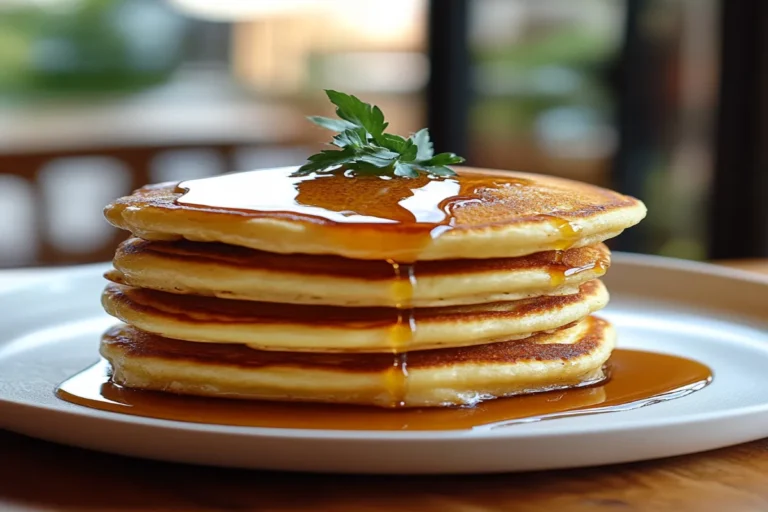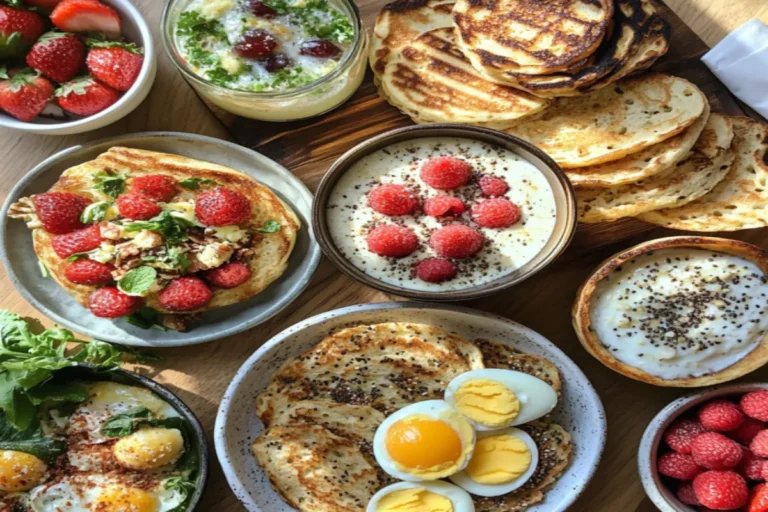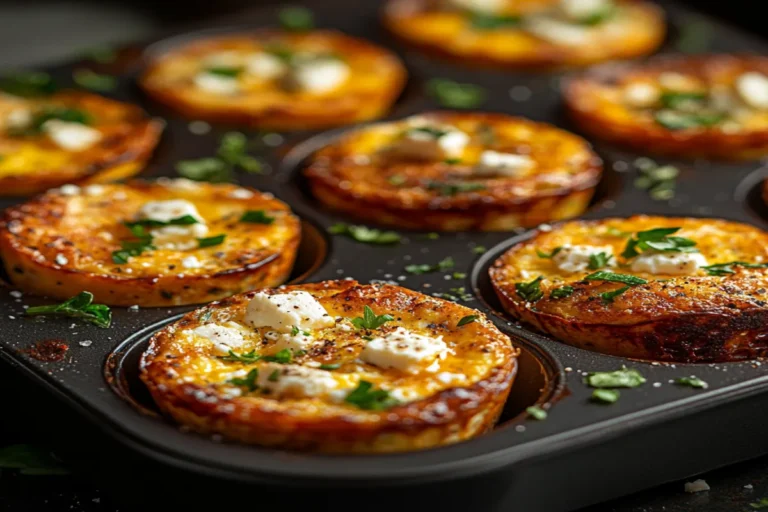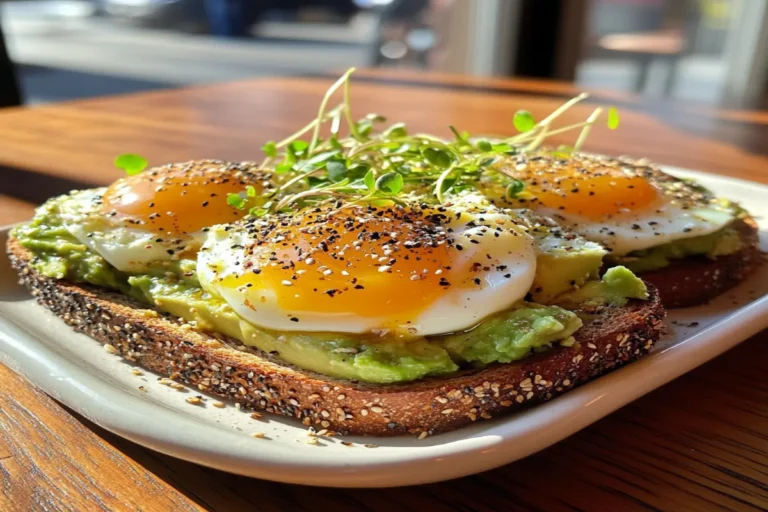Cottage Cheese Pancakes with Chives – Breakfast Recipe
In a world dominated by syrup-drenched pancakes and sugar-laden breakfast options, savory pancakes emerge as the sophisticated, nutritious alternative your morning routine deserves. These aren’t just any pancakes—they’re a delightful contradiction of light yet satisfying, simple yet complex in flavor, and remarkably versatile while staying true to their wholesome ingredients.
My journey with savory cottage cheese pancakes began during a wellness retreat in Vermont, where the chef served these protein-packed delights topped with smoked salmon and a dollop of herbed crème fraîche. The first bite was a revelation—how had I spent decades limiting pancakes to sweet territory when this savory masterpiece existed? Since that morning, these pancakes have become a weekend staple in my home, evolving with the seasons and whatever fresh herbs grace my kitchen window.
At the heart of this recipe are two star ingredients: protein-rich cottage cheese that creates an incredibly tender texture, and fresh chives that provide a subtle onion flavor without overwhelming the palate. Together, they create a breakfast that’s not just delicious but sustaining—the kind that powers you through your morning without the sugar crash that follows traditional pancake offerings.
Table of Contents
The Rise of Cottage Cheese in Modern Diets
Once relegated to diet plates in 1980s diners, cottage cheese has experienced a remarkable culinary renaissance in recent years. This humble dairy product has transformed from a bland diet food into a versatile ingredient celebrated by chefs, fitness enthusiasts, and home cooks alike—and for good reason.
Nutritionally speaking, cottage cheese stands as a powerhouse among dairy products. A single cup provides approximately 25 grams of protein (comparable to many protein powders), making it an exceptional choice for muscle recovery and satiety. Unlike many protein-rich foods, cottage cheese offers this nutritional benefit with relatively low carbohydrate content—typically 6-10 grams per cup, depending on the brand. This protein-to-carb ratio has made cottage cheese particularly popular among those following ketogenic, paleo, or simply balanced diets focused on blood sugar management.
The versatility of cottage cheese extends far beyond these pancakes. Its mild flavor serves as a blank canvas for both sweet applications (with fruit and honey) and savory uses (with herbs, spices, and vegetables). In recent years, creative cooks have incorporated it into smoothies for protein content, used it to create creamy pasta sauces with fewer calories, and even transformed it into healthier cheesecake alternatives.
The texture of cottage cheese—particularly when blended—creates exceptional moisture in baked goods, allowing for reductions in butter or oil while maintaining tenderness. This quality makes it particularly valuable in these pancakes, where it contributes to their distinctively light texture while boosting the nutritional profile substantially.
Ingredient Spotlight: Chives
Threading through these pancakes like delicate green ribbons, chives bring more than just visual appeal to this recipe. As the most refined member of the allium family, chives offer a sophisticated onion flavor that whispers rather than shouts—perfect for morning palates that prefer gentle awakening rather than bold assault.
The mild onion-like taste of chives carries subtle notes of garlic and grass, providing depth to the pancakes without dominating the cottage cheese’s subtle tanginess. When gently folded into the batter and kissed by heat during cooking, chives release their aromatic compounds, infusing the pancakes with a fragrance that signals “savory indulgence” to anyone within range of your kitchen.
Beyond their flavor contribution, chives bring an impressive nutritional profile to these pancakes. They contain significant amounts of vitamins A and K, along with smaller amounts of calcium, iron, and magnesium. Chives also contain various antioxidant compounds including quercetin, which has anti-inflammatory properties—a subtle nutritional boost hidden within these delicious green flecks.
If chives aren’t readily available, several alternatives can step in admirably. Green onions (scallions) provide a similar visual effect with a slightly more pronounced flavor. Garlic chives (Chinese chives) introduce a gentle garlic note while maintaining the delicate texture. For those seeking bolder flavor development, finely chopped leeks or shallots can substitute, though they benefit from a brief sauté before incorporation into the batter.
Selecting the Right Ingredients
Creating exceptional savory cottage cheese pancakes begins with thoughtful ingredient selection, where each component contributes to both nutrition and flavor development.
The foundation of these pancakes—cottage cheese—offers several options worth considering. Full-fat cottage cheese (4%) creates the richest, most tender pancakes with a buttery quality that feels indulgent despite its nutritional virtues. Low-fat varieties (2% or 1%) strike a balance between richness and lightness, making them perhaps the most versatile choice for everyday enjoyment. Non-fat cottage cheese works perfectly well, though it requires more careful cooking to prevent dryness. Whichever variety you choose, small or medium curd works better than large curd, which requires more thorough blending to incorporate smoothly into the batter.
Your flour selection significantly impacts both texture and nutritional profile. Traditional all-purpose flour provides reliability and neutrality, allowing the savory elements to shine. Whole wheat flour introduces nutty undertones and additional fiber but creates a slightly denser texture—consider starting with a 50/50 blend if you’re new to whole grain baking. For gluten-sensitive individuals, a high-quality gluten-free blend containing xanthan gum works beautifully, though you may need to adjust the liquid slightly as these blends often absorb moisture differently.
Eggs serve as the crucial binding element that prevents these protein-rich pancakes from crumbling during cooking. They also contribute additional protein and create air pockets during cooking that lighten the texture. For best results, bring eggs to room temperature before incorporating them into your batter.
The liquid component—typically milk—allows you to fine-tune your pancake consistency. Whole milk creates tender results with subtle richness, while plant-based alternatives like unsweetened almond or oat milk work surprisingly well while reducing the overall dairy content. For pancakes with exceptional tang, buttermilk makes an excellent choice that complements the cottage cheese perfectly.
Beyond chives, consider seasonings that enhance the savory profile. A judicious amount of garlic powder (approximately ¼ teaspoon) adds depth without overwhelming. White pepper provides gentle heat without visual interruption. For dimension, dried dill works in harmony with the chives, while a pinch of dried thyme introduces subtle complexity appreciated by discerning palates.
Step-by-Step Preparation Guide

Creating perfect savory cottage cheese pancakes requires minimal time investment—approximately 10 minutes of preparation and 15 minutes of cooking. This efficiency makes them suitable for weekday breakfasts and weekend brunches alike.
Begin by gathering your ingredients: 1 cup cottage cheese, 3 large eggs, ¼ cup all-purpose flour, 2 tablespoons finely chopped fresh chives, ¼ teaspoon salt, ⅛ teaspoon black pepper, and 1 tablespoon butter or oil for cooking.
For the smoothest texture, process the cottage cheese briefly in a food processor or blender until no large curds remain but the mixture still maintains some texture—about 10 seconds of processing. Alternatively, for pancakes with more textural interest, skip this step and incorporate the cottage cheese as is.
In a medium bowl, whisk the eggs until fully beaten. Add the processed cottage cheese and mix until well combined. The mixture will appear somewhat loose at this stage—this is expected and contributes to the pancakes’ tenderness.
Sprinkle the flour over the mixture and gently fold it in using a spatula rather than a whisk. This gentle incorporation prevents gluten development that could toughen the pancakes. When the flour is about 75% incorporated, add the chopped chives, salt, and pepper, continuing to fold just until everything is combined. Small lumps are perfectly acceptable and preferable to overmixing.
Allow the batter to rest for 5 minutes. This brief resting period allows the flour to hydrate fully and gives the gluten strands time to relax, resulting in more tender pancakes.
Heat a non-stick skillet or griddle over medium heat. When the surface is hot, add a small amount of butter or oil, swirling to coat. Using a ¼-cup measure, portion the batter onto the hot surface, gently spreading each portion to about 4 inches in diameter if necessary.
Cook until bubbles begin to form on the surface and the edges appear set—approximately 2-3 minutes. The pancakes should achieve a golden-brown color on the first side. Flip with a thin spatula and cook for an additional 1-2 minutes until the second side is golden and the pancakes are cooked through.
Serve immediately with complementary toppings. Traditional accompaniments include a dollop of sour cream or crème fraîche, thinly sliced smoked salmon, diced avocado, or a bright tomato relish. For herbaceous enhancement, garnish with additional fresh chives or other soft herbs like dill or parsley.
Tips for Perfect Cottage Cheese Pancakes
Achieving pancake perfection requires attention to several key details that transform good pancakes into exceptional ones.
Batter consistency plays a critical role in texture development. The ideal cottage cheese pancake batter should be thick enough to hold its shape when scooped but still spread slightly when placed on the cooking surface. If your batter appears too thick, add milk one tablespoon at a time until the desired consistency is reached. Conversely, if the batter seems too thin (perhaps due to particularly watery cottage cheese), incorporate an additional tablespoon of flour.
Temperature management is crucial for achieving the perfect balance between exterior crispness and interior tenderness. Maintain a medium heat throughout cooking—high enough to create golden exteriors but gentle enough to allow the centers to cook through without burning the outsides. The pan is at the perfect temperature when a drop of water sizzles upon contact but doesn’t immediately evaporate.
For the most evenly cooked pancakes, resist the urge to press down on them with a spatula during cooking. This compresses the developing air pockets and results in denser pancakes. Instead, allow them to cook undisturbed until the edges appear set and small bubbles form on the surface before flipping.
Enhancing flavor complexity can be achieved through thoughtful additions. A quarter teaspoon of lemon zest brightens the savory notes without making the pancakes taste citrusy. For depth, consider adding a half teaspoon of onion powder or a quarter teaspoon of garlic powder to the dry ingredients.
Proper storage ensures enjoyment of leftover pancakes. Cool completely on a wire rack—this prevents condensation that leads to sogginess. Refrigerate in an airtight container with parchment paper between layers for up to three days. For best reheating results, avoid microwaving, which can make them tough. Instead, warm briefly in a toaster oven or skillet over low heat to restore their exterior texture.
Variations to Try
The versatility of cottage cheese pancakes invites creative interpretation through thoughtful variations that maintain their fundamental character while offering new dimensions of flavor and nutrition.
Incorporate vegetables for additional nutrients and textural interest. Finely chopped spinach (about ¼ cup, with excess moisture removed) introduces vibrant color and mild flavor. Grated zucchini (squeezed to remove moisture) adds remarkable tenderness and subtle sweetness that complements the savory elements. For more pronounced vegetal flavor, roasted red peppers finely diced and folded into the batter create beautiful color contrast and sweet-savory complexity.
Experiment with cheese variations beyond the cottage cheese base. Adding 2 tablespoons of freshly grated Parmesan creates nutty depth perfect for Italian-inspired toppings. Crumbled feta (about 3 tablespoons) introduces briny notes that pair beautifully with Mediterranean flavors. For subtle smokiness, incorporate 2 tablespoons of smoked gouda, finely grated.
Enhance protein content further through strategic additions. Fold in 2 tablespoons of hemp hearts for plant-based protein that contributes subtle nuttiness. Finely chopped cooked bacon (about 3 tablespoons) creates a breakfast hybrid that satisfies intense savory cravings. For elegance, incorporate flaked smoked trout or salmon directly into the batter (about ¼ cup), creating pockets of savory richness throughout each pancake.
Draw inspiration from global cuisines to create distinctive flavor profiles. For Mediterranean-inspired pancakes, add 2 teaspoons of za’atar seasoning and serve with labneh. Create Eastern European blini-inspired variations by incorporating 1 tablespoon of buckwheat flour and serving with cultured cream. For Indian-inspired pancakes, add ½ teaspoon each of ground cumin and coriander, with a pinch of turmeric for golden color.
Frequently Asked Questions
Can I use ricotta instead of cottage cheese?
Yes, ricotta makes an excellent substitute that creates remarkably tender pancakes. The texture difference is notable—ricotta produces a smoother, more uniform batter without the slight curd structure of cottage cheese. Flavor-wise, ricotta offers more subtle dairy notes with less tanginess. When substituting, use an equal amount of ricotta and consider adding an extra pinch of salt to compensate for ricotta’s milder flavor profile. Whole milk ricotta works best for this substitution, as low-fat varieties can sometimes produce drier results.
How do I prevent the pancakes from falling apart?
Structural integrity in these protein-rich pancakes depends on several factors. First, ensure you’re using enough egg—the proteins in egg whites are crucial binding agents. Second, avoid overmixing once flour is added, as this can break down structural development. Allow the batter to rest for 5-10 minutes before cooking to fully hydrate the flour. Most importantly, cook the pancakes until properly set before attempting to flip them—look for set edges and surface bubbles as indicators. If pancakes still seem fragile, adding an additional tablespoon of flour to the batter often solves the issue.
Can these pancakes be made ahead of time?
These pancakes maintain their quality remarkably well when prepared in advance. To make ahead, cook pancakes completely and allow to cool to room temperature in a single layer. Refrigerate in an airtight container with parchment paper between layers for up to three days. For reheating, avoid microwaving, which can create tough texture. Instead, warm in a 300°F oven for 5-7 minutes or briefly toast in a dry skillet over medium-low heat. The pancakes can also be assembled into a make-ahead breakfast stack with toppings and gently warmed before serving.
Are these pancakes freezer-friendly?
These protein-rich pancakes freeze exceptionally well, making them perfect for meal prep. After cooking and cooling completely, arrange in a single layer on a parchment-lined baking sheet and freeze until solid (about 2 hours). Transfer to freezer bags or airtight containers with parchment paper between layers. Properly stored, they maintain quality for up to two months. Reheat directly from frozen in a toaster on a low setting, or in a 325°F oven for 8-10 minutes until warmed through. This freezer-to-table convenience makes them ideal for busy weekday breakfasts.
Conclusion
Savory cottage cheese pancakes represent a delightful paradigm shift in breakfast possibilities—proving that morning meals can be simultaneously nutritious, satisfying, and sophisticated. By embracing protein-rich cottage cheese as the foundation and complementing it with the subtle allium notes of fresh chives, these pancakes offer a canvas for countless flavor explorations while providing sustained energy throughout your morning.
Their remarkable versatility makes them suitable for various dietary approaches, from high-protein fitness regimens to thoughtful carbohydrate management. The simplicity of preparation belies their impressive nutritional profile, making these pancakes accessible even on busy mornings when wellbeing often takes a backseat to convenience.
We encourage you to make these pancakes your own through creative experimentation. Perhaps you’ll discover a seasonal herb combination that becomes your signature version, or a topping arrangement that perfectly balances flavor and nutrition for your personal preferences. We’d love to hear about your adventures with this recipe—share your variations, topping combinations, or serving suggestions in the comments section below.
For those who’ve enjoyed this savory breakfast revelation, consider subscribing to our newsletter for weekly recipe inspiration that challenges conventional thinking about healthy eating. Each week, we share innovative approaches to nutrition that never sacrifice flavor for functionality. Join our community of culinary explorers committed to discovering that truly nourishing food is, by its very nature, delicious food.
Have you embraced the savory breakfast revolution? What other traditionally sweet dishes have you reimagined with a savory twist? We’d love to hear your culinary adventures in the comments below!







